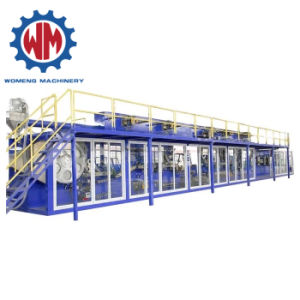The design of a baby pants production line takes into consideration variations in humidity and temperature to ensure stable and reliable manufacturing processes. Fluctuations in these environmental factors can impact the performance of machinery and the quality of the end product.
Here’s how the production line is typically designed to handle variations in humidity and temperature:
- Climate-Controlled Environment:
- The production area is often equipped with climate control systems to maintain stable temperature and humidity levels. This controlled environment helps minimize the impact of external variations on the production process.
- HVAC Systems:
- Heating, ventilation, and air conditioning (HVAC) systems are installed to regulate temperature and humidity. These systems are designed to provide optimal conditions for the machinery and materials used in the production line.
- Insulation:
- The production facility may be insulated to protect it from external temperature fluctuations. Proper insulation helps maintain a consistent internal environment, preventing temperature and humidity variations that could affect production.
- Material Storage Conditions:
- Raw materials used in baby pants production, such as absorbent materials and adhesives, may have specific storage requirements. Design considerations include storage areas with controlled humidity levels to prevent material degradation.
- Sealed Production Areas:
- Critical production areas may be sealed to limit exposure to external environmental conditions. This helps control the manufacturing environment more effectively.
- Machine Enclosures:
- Machines in the production line may have enclosures or covers that protect them from variations in humidity and temperature. This is particularly important for sensitive components and electronic systems.
- Temperature-Resistant Materials:
- The production line may be constructed using temperature-resistant materials that can withstand variations in environmental conditions. This helps ensure the durability of the equipment.
- Temperature Sensors:
- Temperature sensors are integrated into the production line to monitor ambient conditions. These sensors provide real-time data that can be used to make adjustments to the production process in response to temperature changes.
- Humidity Control Systems:
- Humidity control systems, such as dehumidifiers or humidifiers, may be employed to maintain the desired humidity levels. This is important for processes that are sensitive to moisture, such as bonding and sealing.
- Drying Systems:
- For processes that involve wet materials, such as printing or adhesive application, drying systems are implemented to remove moisture efficiently. baby pants production line supplier These systems contribute to maintaining consistent production quality.
- Regular Maintenance:
- Regular maintenance of climate control and environmental systems is essential. This includes checking and calibrating HVAC systems, inspecting insulation, and ensuring that all components are functioning optimally.
- Operator Training:
- Operators are trained to monitor and respond to changes in environmental conditions. They may be instructed to make adjustments to the production process or notify maintenance personnel if there are signs of issues related to temperature or humidity.
- Emergency Protocols:
- Protocols are established to address emergency situations, such as sudden temperature spikes or drops. These protocols may include shutdown procedures or alternative plans to safeguard both the equipment and the quality of the produced baby pants.
By implementing these design considerations, a baby pants production line can effectively manage variations in humidity and temperature, ensuring consistent and reliable manufacturing processes.

